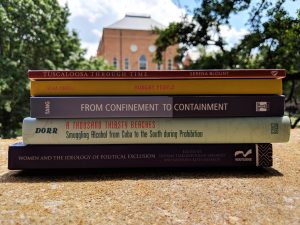
As you relax during the summer months, enjoy these books written by seven A&S faculty, current and retired, from several departments:
Tuscaloosa Through Time
By Serena Blount (English, bloun002@ua.edu)
Over its 200 years of history, the city of Tuscaloosa, Alabama, has held a prominent position within the state, not only as home to the state’s flagship university, but also taking turns as the State Capitol, as the location for the state mental health hospital, as the site of Civil War conflict, and as a Civil Rights landmark. A locale marked by rapid growth at the time of its formal incorporation, today’s Tuscaloosa replicates that rapid development—witnessing industrial and commercial growth, a rising population, and an expanding University.
Blount says, “Expanding my understanding of how varied and complex the experiences of Tuscaloosans have been gives me a greater appreciation for the various perspectives of citizens here, especially those who have lived here for many decades.”
From Confinement to Containment
By Edward Tang (American Studies, etang@ua.edu)
Despite being enemies in World War II, Japan became a “model ally” of the United States when fighting against communism, while Japanese Americans became a “model minority” in the U.S., notwithstanding their wartime mass incarceration. Artists and writers of Japanese ancestry, however, challenged these simplistic postwar transformations through fiction, film, painting, and children’s literature.
Tang explains, “This project allowed me to explore how individuals and societies remember and translate wartime hatreds and sufferings in creative ways that often complicated official understandings of victory or defeat.”
A Thousand Thirsty Beaches
By Lisa Lindquist Dorr (History, lisa.dorr@ua.edu)
Lisa Lindquist Dorr tells the story of the vast smuggling network that brought high-end distilled spirits and, eventually, other cargoes (including undocumented immigrants) from Great Britain and Europe through Cuba to the United States between 1920 and the end of Prohibition. Dorr shows the role smuggling played in creating a more transnational, enterprising, and modern South.
“When I mentioned to southerners that I was writing a book on rum-running in the South, I often heard about where their granddaddy hid his hooch during Prohibition,” says Dorr. “Despite southerners’ long, conflicted history with booze, most people think of New York City and Chicago when they think of rum smuggling. This book shows that the South, with its proximity to the liquor-laden isle of Cuba, played a central role in the illegal liquor market of the 1920s.”
Selling Andrew Jackson
By Rachel Stephens (Art & Art History, rachel@ua.edu)
Selling Andrew Jackson is the first book-length study of the American portrait painter Ralph E. W. Earl, who worked as Andrew Jackson’s personal artist from 1817 until Earl’s death in 1838. In this well-researched and comprehensive volume, Rachel Stephens examines Earl’s role in Jackson’s inner circle and the influence of his portraits on Jackson’s political career and historical legacy.
By investigating the role that visual culture played in early American history, Stephens reveals the fascinating connections between politics and portraiture in order to challenge existing frameworks for grasping the inner workings of early 19th-century politics. Stephens argues that understanding the role Earl played within Jackson’s coterie is critical to understanding the trajectory of Jackson’s career.
Hungry People
By Tasha Coryell (English, tlcoryell@ua.edu)
Hungry People is a collection of short stories that engage with human desire for food, for love, for celebrity, or connection with people around them.
“Many of the stories are based in reality, the same way that horror films are ‘based on a true story.’ I wanted to take reality and make it more satisfying,” explains Coryell.
Women and the Ideology of Political Exclusion
By Tatiana Summers (Modern Languages & Classics, tsummers@ua.edu)
Women and the Ideology of Political Exclusion explores the origin and evolution of the political ideology that has kept women away from centers of political power — from the birth of democracy in ancient Athens to the modern era. This interdisciplinary collection of essays draws on a wide range of literary and historical sources over a span of 2,500 years.
Women may have made great gains toward political power, but they continue to encounter invisible barriers, raised by traditional stereotypes, that block their path to success. Women and the Ideology of Political Exclusion aims to make these barriers visible, raising awareness about the longevity and tenacity of arguments, the roots of which reach classical antiquity.
My Lai: Vietnam, 1968, and the Descent into Darkness
By Howard Jones (History, hjones@bama.ua.edu)
The My Lai Massacre was the mass murder of unarmed South Vietnamese civilians by U.S. troops during the Vietnam War on March 16, 1968. The atrocity intensified opposition to the war, devastating any pretense of American moral superiority. Its effect on military morale and policy was profound and enduring. The Army implemented reforms and began enforcing adherence to the Hague and Geneva conventions.
Compelling, comprehensive, and haunting, based on both exhaustive archival research and extensive interviews, Jones’s My Lai will stand as the definitive book on one of the most devastating events in American military history.